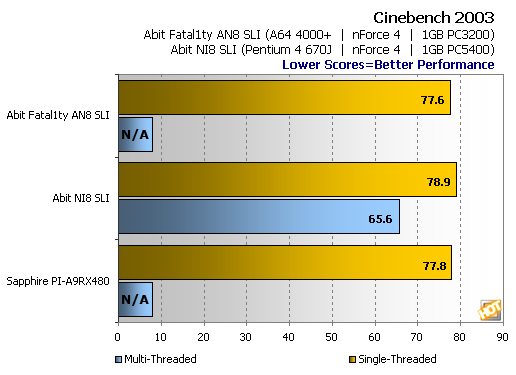Abit SLI Motherboard Showcase
The Cinebench 2003 benchmark is an OpenGL 3D rendering performance test, based on the commercially available Cinema 4D application. This is a multi-threaded, multi-processor aware benchmark that renders a single 3D scene and tracks the length of the entire process. The time it took each test system to render the entire scene is represented in the graph below (listed in seconds).
|

Cinebench 2003's single-threaded test reported very similar performance across all three of the systems we benchmarked. The AMD Athlon 64 4000+ / Abit Fatal1ty AN8 SLI combo finished with the best score, 77.6 seconds, in the single-threaded test, followed by the Sapphire board and then the NI8 SLI. The performance delta was quite small though; only 1.3 seconds separated the "fastest" and "slowest" systems. The Hyper-Threading feature incorporated into the Pentium 4 670J powering the NI8 SLI, however, gives it the ability to run Cinebench in two threads. And when we ran the multi-threaded test, the NI8 SLI smoked the AMD powered systems by about 12 seconds.
|
3DMark05's built-in CPU test is a multi-threaded "gaming related" DirectX metric that's useful for comparing relative performance between similarly equipped systems. This test consists of two different 3D scenes that are generated with a software renderer, which is dependant on the host CPU's performance. This means that the calculations normally reserved for your 3D accelerator are instead sent to the central processor. The number of frames generated per second in each test are used to determine the final score.

Like the CPU test built into PCMark05, the one incorporated into 3DMark05 is multi-threaded, hence the relatively large performance advantage for the Hyper-Threaded Pentium 4 670J powered Abit NI8 SLI. In this test the NI8 SLI was about 10% "faster" than either of the AMD based systems. Taking second place was the Fatal1ty AN8 SLI, followed closely behind by the Sapphire PI-A9RX480.







